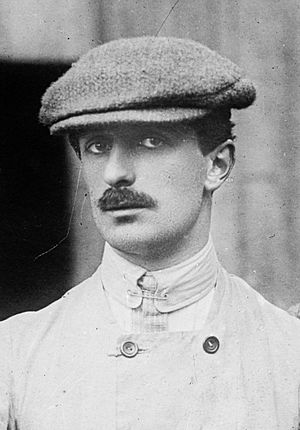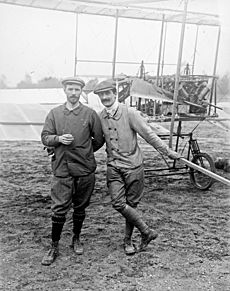Gabriel Voisin facts for kids
Quick facts for kids
Gabriel Voisin
|
|
|---|---|
 |
|
| Born | 5 February 1880 Belleville-sur-Saône, France
|
| Died | 25 December 1973 (aged 93) Ozenay, Saône-et-Loire, France
|
Gabriel Voisin (born February 5, 1880 – died December 25, 1973) was a French aviation pioneer. He helped create Europe's first successful engine-powered aircraft. This plane could fly in a sustained circle for 1 kilometer. Henri Farman flew it on January 13, 1908, near Paris, France.
During World War I, the company Voisin founded became a major maker of military airplanes. One famous model was the Voisin III. After the war, Gabriel Voisin started designing and building luxury cars called Avions Voisin.
Contents
Gabriel Voisin's Early Life
Gabriel Voisin was born in Belleville-sur-Saône, France, on February 5, 1880. His younger brother, Charles Voisin, was his best friend growing up. When their father left the family, their mother, Amélie, moved with her sons to Neuville-sur-Saône. They lived near their grandfather's factory.
Their grandfather, Charles Forestier, taught the boys with strict rules. The brothers also loved exploring the river, fishing, and building many cool gadgets. After his grandfather passed away, Gabriel went to school in Lyon and Paris. He studied industrial design, a field he felt very good at. He often returned home. By the late 1800s, the brothers had built a rifle, a steam boat, and even a car.
First Steps into Flying
After finishing his studies in 1899, Gabriel Voisin joined an architecture company in Paris. While there, he saw the Clément Ader Avion III at the Paris International Exposition of 1900. This sparked his interest in how to make powered flight possible.
After serving in the military, in February 1904, Voisin attended a talk by Captain Ferdinand Ferber. Ferber was a key figure in French aviation at the time. After the talk, Voisin met Ernest Archdeacon, who supported early French aviation with money. Archdeacon hired Voisin to test a glider similar to the Wright brothers' design.
Testing Early Gliders
These glider tests happened in April 1904 at Berck-sur-Mer. They managed some short flights of about 20 meters (66 feet). Archdeacon then asked Voisin to build another glider. This new glider had a fixed horizontal part behind the wings, plus a front-mounted elevator.
On March 26, 1905, they tested this glider at Issy-les-Moulineaux. They pulled it into the air using Archdeacon's car. Luckily, no one was flying it; a 50 kg (110 lb) weight was in the pilot's spot. The aircraft broke apart and crashed. It was not rebuilt.
Flying on Water
Voisin then designed a glider with floats for Archdeacon. This aircraft was special because it used "Hargrave cells" for its tail and wings. On June 8, 1905, Voisin successfully flew it. A motorboat pulled it into the air on the river Seine. He flew about 600 meters (1,969 feet).
While working on this glider, Louis Blériot asked Voisin to build him a similar machine. This became known as the Bleriot II. After the first flight, Blériot suggested they work together to build aircraft. So, Voisin stopped working with Archdeacon.
On July 18, 1905, Voisin tried to fly both aircraft. The weather was bad with strong winds, but he flew anyway because it was hard to get permission to use the river. He made a short flight in his own glider. Then he tried Blériot's. It took off quickly, but Voisin couldn't control it, and it crashed into the river. Voisin was trapped inside but managed to escape drowning. Film footage of this event is still kept at the Smithsonian's National Air and Space Museum.
New Designs and Partnerships
The next aircraft Voisin built for Blériot in 1906 was the Bleriot III. It was a biplane with two wings, powered by an Antoinette engine. It had two propellers at the front. This aircraft didn't work well. Its improved version, the Blériot IV, also failed.
After these failures, Voisin and Blériot ended their partnership. Gabriel Voisin then started a company with his brother Charles Voisin to design and build airplanes.
Building Airplanes for Sale: Voisin Frères

Appareils d'Aviation Les Frères Voisin was the world's first factory to build and sell airplanes. At this time, European aviators were racing to be the first to achieve powered flights. Many people didn't believe the Wright brothers' claims of long, sustained flights until Wilbur Wright showed them in France in August 1908. For example, the Wrights' Wright Flyer III had flown 38.9 km (24 miles) in 39 minutes in 1905.
Alberto Santos-Dumont made Europe's first officially watched and confirmed powered flights in November 1906 with his 14-bis plane. Even though it was famous, the 14-bis could only fly short distances in a straight line. It wasn't developed further and was soon abandoned.
Europe's First Successful Aircraft
The Voisin brothers built two very similar biplanes with Antoinette engines. The first was for Leon Delagrange in March 1907. The second was for his friend and rival Henri Farman in October 1907. This second plane became known as the Voisin-Farman I.
Farman flew this plane to win Archdeacon's Grand Prix d'Aviation. He made the first 1-kilometer closed-circuit flight on January 13, 1908. Both Farman and Delagrange became very famous with these aircraft. They competed for aviation records. The Voisin brothers' planes became known as Europe's first successful aircraft.
In 1909, Voisin received the Chevalier of the French Legion of Honor. He also won the Prix Osiris from the Institut de France with Blériot. In the same year, Voisin married Adrienne-Lola Bernet, and they had a daughter named Janine.
Later, Farman improved the Voisin biplane a lot. He eventually stopped working with the Voisin brothers after a disagreement. He then started making his own airplane designs, which became very successful. The Voisin brothers continued to expand their factory. One of their later designs was the Canard Voisin in 1911.
Gabriel Voisin's Company After His Brother's Death
Gabriel Voisin was deeply saddened when his brother Charles Voisin died in a car accident in 1912. The accident happened near Belleville-sur-Saône. Despite this, Gabriel continued to expand the factory in Boulogne-Billancourt. He changed the company name to Société Anonyme des Aéroplanes G. Voisin.
After 1912, the factory focused on making planes for the French military. When World War I began in 1914, Voisin immediately volunteered for the French air force.
Voisin Airplanes in World War I
The Voisin III was a two-seater biplane with a 120 horsepower Salmson engine. It was widely used for bombing and observation missions during World War I. It had a light steel frame, so it could be kept outdoors. About 1,000 Voisin III planes were built between 1914 and 1916. They were sold to the French air services and other allies, including Russia.
Later models, the Type VIII (about 1,100 built) and Type X (about 900 built), were delivered in 1917 and 1918. These later Voisin military aircraft looked very similar to the Voisin III. However, they were heavier and had engines twice as powerful, made by Peugeot and Renault. They could also fly farther and carry almost twice the bomb load of the Voisin III.
A complete and original Voisin Type VIII bomber aircraft is kept in excellent condition at the Smithsonian's National Air and Space Museum in Washington, D.C. It is the oldest preserved bomber aircraft in the world.
From Airplanes to Cars: Avions Voisin
After the war, Voisin stopped making airplanes. He said it was because of the terrible military use of his advanced planes during the war. From then until 1958, he focused on making cars under the brand Avions Voisin.
His early cars were some of the most luxurious vehicles in the world. They had unique technical features. Many of them won races and competitions. However, the market for luxury cars shrunk in the 1930s due to tough economic times. Then, in June 1940, Nazi Germany invaded France, forcing him to close his factory.
After 1945, he designed a very simple car for everyone, called the Biscooter. Thousands of these were made under license in Spain during the 1950s as the Biscúter. Today, his luxury cars from before the war are highly valued by collectors in Europe and the USA.
In the 1920s, his company also offered a 'Motor-Fly'. This was a bicycle with a small engine added to the back wheel. They also produced pre-made houses that could be built in just three days. These houses came in different sizes and were built around a metal frame. Some of these houses still exist, though they have been changed over time. The houses had the logo 'Avion Voisin Issy', just like his other products.
Later Years and Passing
In 1960, Gabriel Voisin retired to his country home, "La Cadolle." It was near Tournus on the banks of the Saône river. There, he wrote his life story. A few years later, in 1965, he was made a Commander of the Legion d'Honneur.
He passed away on Christmas Day, December 25, 1973, in Ozenay, Saône-et-Loire. He was 93 years old. He was buried at Le Villars.
See also
 In Spanish: Gabriel Voisin para niños
In Spanish: Gabriel Voisin para niños
- Léon Lemartin – engineer on the Seine glider and the Gnome Omega rotary engine.


